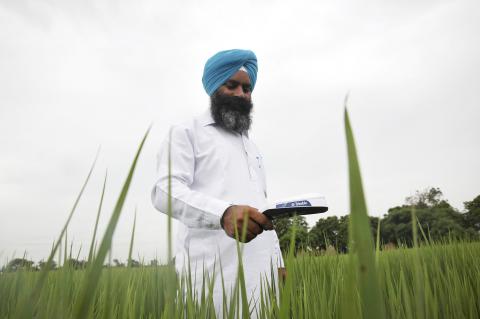Erratic weather, rising temperatures, declining water resources and labor shortages are threatening India’s bread basket state of Haryana, forcing farmers to abandon age-old practices and adopt technology to ensure food supplies for millions.
Using machines that sow rice directly, devices to inform when to irrigate and phone messages warning of infestations, thousands of farmers are learning to adapt to climate change, boost soil fertility and reduce their carbon emissions.
“At first, many farmers were unsure. It’s a big risk to change the way you have farmed for decades and try new things. Agriculture in these parts is not just a livelihood, it’s a way of life,” said Harpreet Singh, 36, a farmer in the village of Birnaraya, 130km north of Delhi.

Photo: Reuters
“But over the last four years, through these technologies, we have learned to save water and fertilizers, cut our costs for hired labor, improved the resilience of our crops and also reduced pollution by not burning crop residues,” he said.
Singh is from one of 12,000 farming households across 27 villages in Haryana’s Karnal District working with scientists from the Consultative Group on International Agricultural Research to pilot climate smart techniques aimed at sustaining one of the nation’s most fertile belts.
Since India’s so-called “Green Revolution” — a massive government program rolled out in the 1960s and 1970s that increased the use of fertilizers and irrigation to boost farm output — Haryana’s rice production has soared to almost 4 million tonnes in 2013-2014 compared with 334,000 tonnes in 1966-1967.
However, while the Green Revolution may be credited with ending famine across the country, it has come at a cost and, coupled with more unpredictable weather attributed to global warming, India’s food security is once again at risk.
Almost half a century on, farmers face environmental problems such as depleted groundwater because of intensive pumping for irrigation, soil degradation and soil salinity.
“Resources are depleting. Groundwater levels are falling, there is emerging climate variability, the soil health is worsening and profitability is going down,” said M.L. Jat, an agronomist with the International Maize and Wheat Improvement Center.
The Indo-Gangetic Plains — which include the rice and wheat states of Haryana and Punjab — are particularly vulnerable to climate change, experts from the UN Intergovernmental Panel on Climate Change say.
Scientists predict average temperatures here would increase by as much as 5°C by 2080, seriously affecting wheat crops. An April study by the Indian Agricultural Research Institute projects climate change may reduce India’s wheat yield by between 6 and 23 percent by 2050.
Rice will also be hit due to unpredictable rainfall. Indian officials say the water table has fallen between 1m and 13m in different parts of Karnal over the past two decades.
The region, which is heavily dependent on migrant labor from poorer states, is also facing shortages due to a government scheme to employ more people in construction near their homes.
In response to these challenges, agricultural groups are introducing Karnal’s farmers to a host of climate smart technologies.
These include techniques such as direct seeding, which involves sowing seeds by machines rather than transplanting manually, reducing labor and water.
Other new technology includes laser lavelers — tractor-towed, laser-controlled devices that produce a flat surface for cultivation, requiring 25 to 30 percent less water.
Farmers are being introduced to tools such as “Happy Seeders,” which can be attached to the back of tractors. These remove crop residues, blending them into the soil, preventing the practice of burning crop residues that has led to increased emissions and depleted soil fertility.
“We didn’t know anything about these advanced technology machines before,” said Manoj Kumar Munjal, 40, who farms an 8-hectare plot of land in Taorori Village.
“We have learned about these machines and set up a cooperative where we all put in the money together and bought machines and share them. Now everyone is using it,” he said.
Farmers also receive voice messages giving weather forecasts, informing them of new seed varieties and infestations.
However, these technologies do not come cheap. A laser leveler, for example, costs more than US$6,000.
In villages such as Munjal’s, farmers have clubbed together to buy new machinery, while in others, one farmer invests in the hardware and rents it out to others.
The Consultative Group on International Agricultural Research said a similar project is under way in the eastern state of Bihar using lower cost techniques on smaller plots.
On his sprawling 36-hectare farm, Harpreet Singh crouched down amongst his rice paddy stalks and checked his tensiometer, a device planted in the ground to measure moisture content.
Singh said that over the past four years, his income has increased by 15 percent due to savings made on electricity for irrigation, diesel for residue burning, labor and fertilizers. However, it is the saving on water that satisfies him the most.
“Day by day, the ground water levels are going down and down. If we continue like this, it’s only a matter of time before we don’t have water to drink, let alone to farm,” he said.

Merida Industry Co (美利達) has seen signs of recovery in the US and European markets this year, as customers are gradually depleting their inventories, the bicycle maker told shareholders yesterday. Given robust growth in new orders at its Taiwanese factory, coupled with its subsidiaries’ improving performance, Merida said it remains confident about the bicycle market’s prospects and expects steady growth in its core business this year. CAUTION ON CHINA However, the company must handle the Chinese market with great caution, as sales of road bikes there have declined significantly, affecting its revenue and profitability, Merida said in a statement, adding that it would

MARKET LEADERSHIP: Investors are flocking to Nvidia, drawn by the company’s long-term fundamntals, dominant position in the AI sector, and pricing and margin power Two years after Nvidia Corp made history by becoming the first chipmaker to achieve a US$1 trillion market capitalization, an even more remarkable milestone is within its grasp: becoming the first company to reach US$4 trillion. After the emergence of China’s DeepSeek (深度求索) sent the stock plunging earlier this year and stoked concerns that outlays on artificial intelligence (AI) infrastructure were set to slow, Nvidia shares have rallied back to a record. The company’s biggest customers remain full steam ahead on spending, much of which is flowing to its computing systems. Microsoft Corp, Meta Platforms Inc, Amazon.com Inc and Alphabet Inc are

RISING: Strong exports, and life insurance companies’ efforts to manage currency risks indicates the NT dollar would eventually pass the 29 level, an expert said The New Taiwan dollar yesterday rallied to its strongest in three years amid inflows to the nation’s stock market and broad-based weakness in the US dollar. Exporter sales of the US currency and a repatriation of funds from local asset managers also played a role, said two traders, who asked not to be identified as they were not authorized to speak publicly. State-owned banks were seen buying the greenback yesterday, but only at a moderate scale, the traders said. The local currency gained 0.77 percent, outperforming almost all of its Asian peers, to close at NT$29.165 per US dollar in Taipei trading yesterday. The

The US overtaking China as Taiwan’s top export destination could boost industrial development and wage growth, given the US is a high-income economy, an economist said yesterday. However, Taiwan still needs to diversify its export markets due to the unpredictability of US President Donald Trump’s administration, said Chiou Jiunn-rong (邱俊榮), an economics professor at National Central University. Taiwan’s exports soared to a record US$51.74 billion last month, driven by strong demand for artificial intelligence (AI) products and continued orders, with information and communication technology (ICT) and audio/video products leading all sectors. The US reclaimed its position as Taiwan’s top export market, accounting for